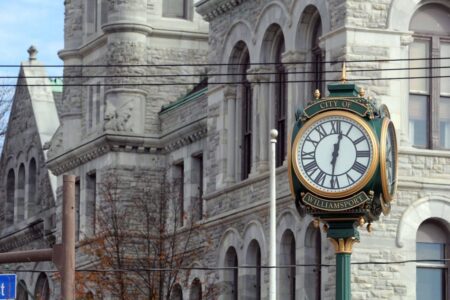City of Williamsport’s preliminary budget calls for tax increase
The 2026 City of Williamsport budget calls for a proposed half-mill tax hike and shows a $1.4 million deficit, a far more favorable position than what had been projected, but one that will keep being worked on through December, city officials said.
Mayor Derek Slaughter told City Council in his statement Monday night, initially, there was a $4.2 million deficit next year, but there was work to reduce that to what is a proposed 17.55 mills of real estate tax.
The half-mill tax increase proposed combined with increase in assessed taxable value results in about $413,000 in additional real estate tax revenue, Slaughter said.
Slaughter gave kudos to the administrative staff, noting efforts by Jamie Livermore, director of finance, and appreciation to Public Financial Management (PFM) of Philadelphia, the consultant helping the city on its strategic management plan.
There is a proposed 7% increase in anticipated revenue, Livermore said.
This anticipated increase reflects a one-time transfer of Bowman Field income.
It includes the 2024 transfer from the emergency and reserve fund and it includes proceeds from the sale of City Hall, Slaughter said.
Next year’s expenditures are expected to increase by about 1.3%. This increase includes rising medical and pension costs. There were several one-time reductions made in 2025 to help offset the anticipated deficit. These one-time reductions include removal of budget for the capital savings across the departments, street reconstruction and the brick streets budget.
The proposed salary budget as presented includes a 2% increase across the board for each of the departments. Two union contracts are in negotiation and one is in arbitration, he said.
Salary figures for police, streets and parks and City Hall bargaining units include an estimated 2% increase solely for budgeting purposes.
“These estimates are not negotiated or agreed upon terms and may be revised to reflect the final results of bargaining and the arbitration,” Slaughter noted.
He said he considered the year to have shown outstanding progress in terms of a clearer financial picture – with the 2023 audit completed and the 2024 audit underway and the 2025 audit, which is projected for completion by no later than this time next year.
Slaughter offered highlights on the work done by the community and economic development and planning department team. The grants administrator secured funding for key capital projects including more than $1.2 million for significant Bowman Field upgrades, full funding for $806,400 in the Youngs Woods Park improvement project, and the restart of the $906,475 downtown safety improvements project.
Additional success included a $200,000 state Department of Transportation multimodal grant for West Third Street, pedestrian enhancements, and a $360,458 U.S. Department of Transportation Safe Streets and Roads for All grant. This grant is for the development of a citywide action plan and completion of the Mulberry Street traffic signal modernization.
Beyond infrastructure the department strengthened policies, partnerships and community services and its staff collaborated with UPMC and Loyalsock Township to advance a new bicycle safety corridor connecting Shaw Park with Millers Run Greenway. It is a bike loop that is projected to go from Shaw Park west to Brandon Park and connect to points along the Susquehanna Riverwalk, based on prior discussion with Bill Scott, city engineer.
The department also streamlined the local economic tax assistance (LERTA) processes and played an active role in the Williamsport Business Association’s downtown strategic plan.
The city earned a “Birdtown” designation through the Pennsylvania Audubon Council.
Also, Slaughter said, significant progress was made in housing programs, with updated HOME policies, the relaunch of the emergency rehab program and renewed planning for expanded housing initiatives next year.
A summer intern contributed valuable analysis through a Geographic Information System (GIS) needs study and a comprehensive report on Grafius Run, to control future flooding events.
Together, he said, it was a year “demonstrating momentum and meaningful community impact.”
With the improved accuracy of the reported revenues and expenditures the city now has a clear financial picture, Slaughter noted.
He was optimistic but noted how continual improvements need to be done.
“Despite the progress, as we all know substantial fiscal challenges still lie ahead,” he said.
“In cooperation with City Council, the administration and PFM we will use the 2026 strategic plan to guide the city forward into financial resilience.”
The strategic plan in place is a $124,000 effort by PFM paid for by 90% of grant coverage through the state DCED and 10% from the city. Already, the mayor notes, recommendations by the firm have provided a roadmap for 2026 and beyond that city officials can use.





